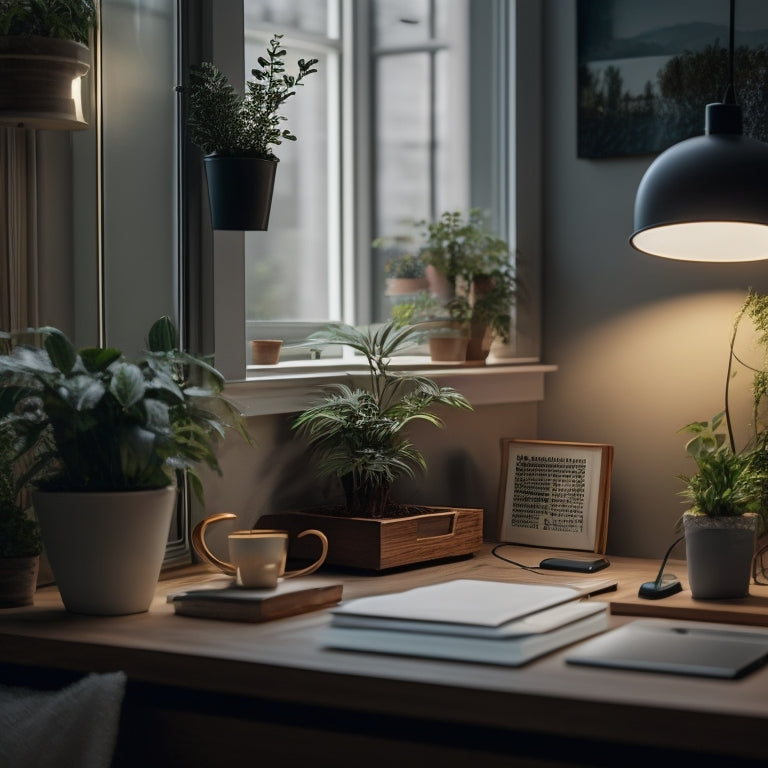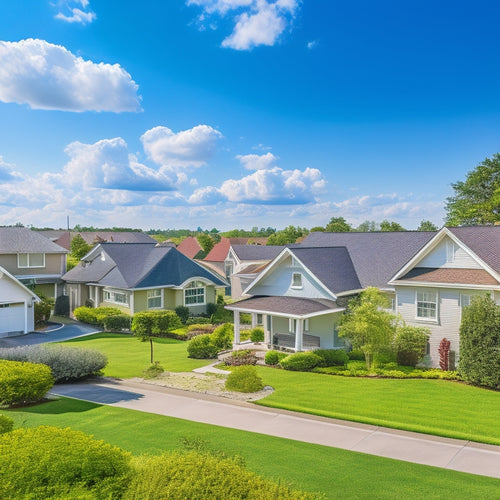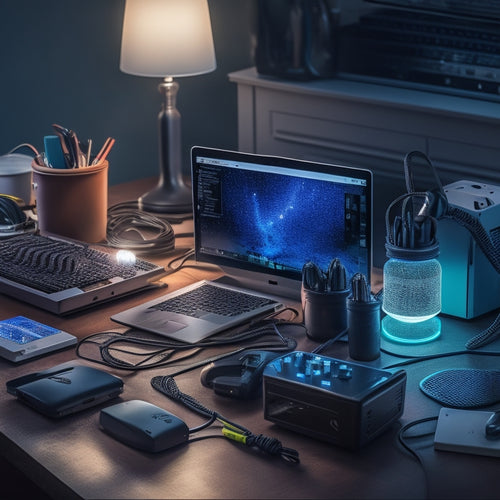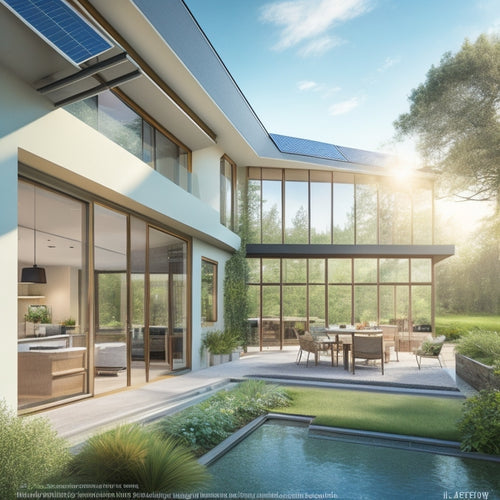
What Home Office Power Strategies Save Energy?
Share
You can reduce your home office's energy consumption and environmental impact by embracing a combination of energy-harvesting power sources, smart energy management strategies, energy-efficient devices, and sustainable design principles. Start by exploring solar energy, kinetic energy harvesting, and environmental energy conversion to reduce your reliance on the grid. Implement smart plug energy monitoring, scheduled power shutdowns, and automatic power cutoffs to optimize your energy usage. Choose low-power mode devices, energy-efficient lighting options, and sustainable materials for your office design. By adopting these strategies, you'll not only lower your energy bills but also contribute to a greener future - and that's just the beginning of your energy-saving expedition.
Key Takeaways
- Utilize energy-harvesting power sources like solar energy, kinetic energy harvesting, and environmental energy conversion to reduce grid reliance.
- Implement smart energy management through smart plug energy monitoring, scheduled power shutdowns, and automatic power cutoff features to minimize energy consumption.
- Choose energy-efficient devices with low-power modes, eco-friendly options, and power-saving features to reduce energy waste and operating costs.
- Opt for energy-efficient lighting options like LED technology, which consumes up to 90% less energy than traditional incandescent bulbs.
- Incorporate energy-efficient design strategies, such as using sustainable materials, ergonomic furniture, and renewable energy incentives, to minimize carbon footprint and reduce energy bills.
Energy-Harvesting Power Sources
As you investigate alternatives to traditional power sources, energy-collecting power sources emerge as a promising solution for your home office. These innovative technologies convert environmental energy into electrical power, reducing your reliance on the grid.
Solar energy, for instance, utilizes the sun's rays to generate electricity. You can integrate solar panels into your home office's infrastructure, providing a clean and sustainable power source. By shifting to renewable energy, you can minimize your carbon footprint and operating costs, and even future-proof your business.
Another option is kinetic energy harvesting, which captures the energy generated by movement or vibrations. This technology can be used to power small devices, such as sensors or wearables.
Smart Plug Energy Monitoring
Frequently, you may find yourself wondering which devices in your home office are consuming the most energy. This is where smart plug energy monitoring comes in. By plugging your devices into smart plugs, you can track their energy usage in real-time, identifying which ones are guzzling the most power.
With the increasing adoption of electric vehicles, it's crucial to take into account the strain on the grid and investigate renewable energy solutions to reduce our carbon footprint. This information allows you to make informed decisions about which devices to upgrade or replace with energy-efficient alternatives.
Smart plug benefits include remote monitoring, scheduling, and automation, giving you greater control over your energy consumption. Additionally, most smart plugs are compatible with popular voice assistants and can be integrated with existing smart home systems, making it easy to incorporate them into your setup.
Low-Power Mode Devices
You're likely familiar with the importance of reducing your home office's carbon footprint, and that's where low-power mode devices come in. By opting for eco-friendly device options, you can greatly decrease energy consumption, and many devices now come with power-saving features enabled by default.
When selecting devices, remember that energy-efficient design matters, and even small changes can add up to make a big difference in your overall energy usage. For instance, selecting energy-efficient charging equipment with high energy ratings can minimize losses and reduce operating costs.
Additionally, optimizing your device's performance through regular monitoring and maintenance can guarantee uptime and maximize energy production.
Eco-Friendly Device Options
Eco-friendly device options can greatly reduce your home office's carbon footprint. By choosing devices with low power consumption, you can minimize energy waste and lower your utility bills.
Consider the following eco-friendly device options for your home office:
-
Energy-efficient printers: Look for printers with low wattage and Energy Star certification. Shifting to renewable energy sources, such as solar and wind power, can also considerably reduce your carbon footprint renewable energy sources.
-
Solar chargers: Capture the power of the sun to charge your devices, reducing your reliance on grid electricity. This is especially useful for EV owners who can employ solar-powered fast charging hubs.
-
Low-power mode monitors: Opt for monitors with built-in power-saving features, such as automatic brightness adjustment and sleep mode.
Conducting regular energy audits can help you identify areas for improvement and optimize your home office's energy efficiency.
Power-Saving Features Enabled
With power-saving features enabled, your devices can greatly reduce energy consumption without compromising performance. Many devices come with low-power modes that can be activated to conserve energy.
You can take advantage of power management features like sleep mode or hibernate to reduce energy consumption when devices aren't in use. In addition, you can optimize your devices by adjusting settings to reduce power consumption. For instance, you can lower the screen brightness, turn off unnecessary features, or use energy-efficient settings.
By utilizing solar-powered systems, you can also reduce your reliance on the grid and minimize your environmental footprint. Moreover, considering the installation of commercial EV charging stations can lead to potential annual savings of $500 to $2,000+.
Energy-Efficient Design Matters
One significant aspect of home office power strategies is the incorporation of devices designed with energy efficiency in mind.
This approach not only reduces your environmental footprint but also saves you money on your energy bills.
When setting up your home office, consider the following energy-efficient design elements:
-
Low-power mode devices: Look for devices with low-power mode or sleep mode features that consume minimal energy when not in use.
-
Sustainable materials: Choose furniture and decor made from sustainable materials that reduce waste and minimize environmental impact.
-
Ergonomic furniture: Invest in ergonomic furniture that promotes comfort and productivity while reducing the need for excessive lighting and heating.
Energy-Efficient Lighting Options
About 20% of your home office's energy consumption is attributed to lighting, making it a prime area for optimization.
You can greatly reduce your energy consumption by switching to energy-efficient lighting options. LED technology advancements have made it possible to achieve high-quality lighting while using considerably less energy.
LED bulbs, for instance, use up to 90% less energy than traditional incandescent bulbs. Additionally, they've a longer lifespan, reducing the need for frequent replacements.
By adopting sustainable lighting solutions, you can minimize your carbon footprint and enjoy substantial energy savings.
Consider replacing traditional lighting fixtures with energy-efficient alternatives, such as LED desk lamps or overhead lighting, to create a more eco-friendly home office.
Scheduled Power Shutdowns
You can implement scheduled power shutdowns to optimize your home office's energy efficiency.
By establishing a daily shutdown routine, you can guarantee that devices and equipment are turned off when not in use, reducing standby power consumption.
Automatic power cutoff features can also be configured to turn off devices after a specified period of inactivity, further minimizing energy waste.
Daily Shutdown Routine
Implementing a daily shutdown routine as part of your home office power strategy can greatly reduce energy consumption and prolong the lifespan of your devices.
By incorporating this habit into your remote work habits, you'll not only save energy but also reduce your environmental impact.
-
Shut down your computer and peripherals when not in use, especially during extended breaks or at the end of your workday.
-
Unplug chargers and adapters to eliminate standby power consumption, also known as "vampire power."
-
Turn off unnecessary lights and equipment, such as printers, scanners, or monitors, to further minimize energy consumption.
Automatic Power Cutoff
One effective way to take your home office power strategy to the next level is to set up automatic power cutoffs, also known as scheduled power shutdowns.
This power management technique guarantees that your devices are turned off when not in use, eliminating standby power consumption. You can schedule shutdowns for specific times of the day or night when you're not working.
By doing so, you'll optimize your device usage and reduce energy waste. For instance, you can set your computer to shut down automatically at 6 pm every day, or your printer to turn off after a certain period of inactivity.
Renewable Energy Incentives
Renewable energy incentives are becoming increasingly attractive to homeowners seeking to reduce their reliance on traditional power sources.
You can take advantage of these incentives to power your home office with clean energy while saving money.
Here are three incentives you can consider:
-
Federal Tax Credits: Claim up to 30% of the total cost of your solar or wind system as a tax credit.
-
State and Local Rebates: Many states and local governments offer additional rebates and incentives for renewable energy installations.
-
Green Financing Options: Investigate special financing options for renewable energy projects, such as property assessed clean energy (PACE) financing or energy-efficient mortgages.
Frequently Asked Questions
Can I Use Energy-Efficient Devices in a Non-Dedicated Home Office Space?
Imagine working freely in your non-dedicated home office space, surrounded by energy-efficient devices. You can replace old printers with multifunction printers and plug them into smart power strips, effortlessly saving energy while maintaining your independence.
How Do I Calculate the Energy Consumption of My Home Office Equipment?
You calculate your home office energy consumption by identifying the equipment wattage, then multiplying it by the number of hours used daily, giving you the total daily energy consumption in watt-hours (Wh).
Are Energy-Efficient Home Office Devices More Expensive Than Traditional Ones?
Imagine gauging gold and lead; energy-efficient devices might tip the scale with a higher upfront cost, but you'll reap long-term savings, breaking free from the shackles of high energy bills, as you calculate the cost comparison, and invest in a greener future.
Can I Save Energy by Turning off Devices During Coffee Breaks?
When you're on a coffee break, you can save energy by turning off devices; this habit helps reduce device standby consumption, which can account for up to 10% of your home office energy usage, so make it a habit to switch them off.
Will Energy-Efficient Home Office Devices Compromise on Performance?
When you opt for energy-efficient home office devices, you'll find they don't compromise on performance; in fact, they often outperform traditional devices in performance comparison, while maintaining exceptional device effectiveness, giving you the freedom to work efficiently and guilt-free.
Related Posts
-

What Cool Roof Tax Breaks Can Homeowners Claim?
You can claim federal tax credits of up to $500 and state and local incentives for installing cool roofs, which not o...
-

What Do Power Strips Do for Standby Energy?
You're likely aware that your devices, such as TVs and computers, continue to draw power even when turned off, a phen...
-

5 Efficient Air Circulation Methods for Green Homes
You can utilize the power of natural ventilation techniques, whole house fans, and solar-powered ventilation systems ...


